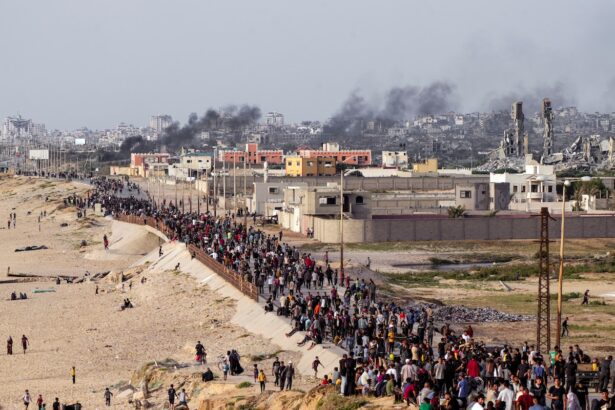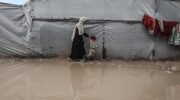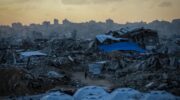Fighting in the north and south has deepened Gaza’s humanitarian crisis and reversed recent gains by aid groups in staving off starvation and disease.
By Kareem Fahim, Louisa Loveluck, Loveday Morris and Mohamad El Chamaa, reposted from The Washington Post, May 22, 2024
More food had finally started to reach famine-racked northern Gaza earlier this month, pushing down prices in the Jabalya refugee camp, where doctors like Yehia Abed were trying to save a legion of malnourished patients. Then came “another attack,” he said.
Israeli military operations this month against Hamas in Gaza — from the last, desperate refuge for Palestinians in the southern city of Rafah to the devastated refugee camps of the north — have displaced nearly a million people, according to the United Nations, and further sealed off the territory to outside aid. Aid groups say it has deepened the enclave’s humanitarian crisis and reversed their recent gains in staving off starvation and disease.
Now, aid workers said, they are resorting again to triage.
“Instead of looking at antenatal care for pregnant ladies, instead of looking at malnutrition, now we are looking at how to stop the bleeding,” Abed said in a phone interview, as an explosion rang out in the background. “That’s continuous,” he said. “Day and night.”
Gaza’s latest trial started in early May, when Israel issued evacuation orders in parts of Rafah, signaling the start of a long-threatened invasion it said was aimed at destroying Hamas’s remaining battalions. Aid agencies warned for months that an offensive in an area sheltering more than a million people would be disastrous.
It is every bit the calamity they feared, they say.
As fighting intensified in the east of Rafah, along with Israeli bombardment and artillery shelling across the city, hospitals and clinics were shuttered. Warehouses storing thousands of tons of food supplies became unreachable. Border crossings that were southern Gaza’s lifeline were closed or hard to access, keeping food, nutritional supplements and medicines out — and thousands of critically injured patients penned in.
Aid officials have watched in horror and disbelief as nearly half of Gaza’s population has been forcefully displaced in just over two weeks, with uprooted families struggling to find any open patch of land to settle on. Humanitarian groups have been left with little notion of how, and where, to serve the starving, the injured and the sick.
It was “potentially the darkest chapter in this horrendous war that started seven months ago,” Ricardo Pires, a spokesman for UNICEF, said last week as the disaster unfolded.

More than 800,000 people have fled in southern Gaza, according to the United Nations, and at least 100,000 have been displaced from parts of the north, where Israel has also launched a new offensive against Hamas cells that have regrouped in the enclave’s widening power vacuum.
The luckiest people are sheltering in tents, which are now sold for hundreds of dollars, residents said. Others have settled in abandoned buildings. Alaa Hassan, 31, fled Rafah on a donkey cart because he could not afford a car, with curtains from his abandoned home for shelter because he could not pay for a tent. He settled in Mawasi, on the coast, which Israel has touted as part of a “humanitarian area.”
Announcing the expansion of the zone in a post on X on Wednesday, Lt. Col. Avichay Adraee, the Arabic-language spokesman for the Israel Defense Forces, promised displaced Gazans “the necessary humanitarian services … such as food, water, medical services, supplies, and more.”
Hassan said Mawasi was all but uninhabitable: “There is no drinking water, sanitation or even bathrooms.”
The Biden administration said for months that it was discouraging Israel from carrying out a major operation in Rafah and was demanding a “credible” plan to evacuate and protect civilians. In early May, President Biden threatened to withhold U.S. munitions if Israel moved into the city’s population centers. But the offensive has emptied those population centers; sprawling tent cities vanished almost overnight. And despite the chorus of alarm from aid workers, U.S. officials have not objected to the operation.
“Israel’s military operations in that area has been more targeted and limited,” U.S. national security adviser Jake Sullivan said Wednesday.
“We are running out of words to describe what is happening in Gaza,” Edem Wosornu of the U.N. humanitarian agency said in a briefing Tuesday. “We have described it as a catastrophe, a nightmare, as hell on Earth. It is all of these, and worse.”
Rafah — the most vital aid crossing on the border with Egypt — is closed. Thousands of trucks sit idle, some with perishable goods spoiling in the summer heat. The only two crossings into Gaza that are nominally open are seen by aid agencies as unusable — because of fighting or because they sat in Israel’s evacuation zones.

Near Kerem Shalom, an Israeli crossing in southern Gaza, the situation was “kinetic,” said Olga Cherevko, a spokeswoman for the U.N. humanitarian agency. There were “tons of explosions, a lot of fighting,” she said. The crossing was “not viable for us at all.”
A floating pier constructed by the U.S. military in central Gaza received supplies last week, but a large portion of the food that arrived was seized by desperate people as it left the dock, the Pentagon said Tuesday. Aid officials have repeatedly stressed that the pier is no substitute for land crossings.
“Aid is flowing,” Sullivan said Wednesday. “It is not flowing at the rate that any of us would be happy with, because we always want more.”
Distribution of food packages in southern Gaza has been halted because aid agencies can no longer access supplies, officials said in recent days. Bakeries — which were reopening before the offensive — have shut down or are expected to soon.
The World Food Program said it is continuing to distribute hot meals in parts of Gaza, though the United Nations said community kitchens were running out of cooking gas. Aid officials said a few goods were still available in markets — as some commercial shipments continued — but no one could afford them.
While she was sitting in traffic in southern Gaza this week, Cherevko said, she saw a middle-aged man trying to buy goods at the market. He settled on four eggs, she said.
“No Gazan family buys four eggs. You buy a couple of dozen, because they have big families,” she said. But no one had any money.
Given the shortages and privation, Gaza’s malnutrition crisis was certain to worsen, aid workers said. In early May, the director of the World Food Program said that northern Gaza was in “full-blown famine.” Now, in the south, it was not “far-fetched” to assume that famine had taken hold there, too, said Pires, the UNICEF spokesman.
“We had seen some progress in terms of getting aid in” before Israel’s offensive in Rafah. But a system designed to stave off famine, including service points that provided screening and nutritional supplements, had now “completely collapsed,” he said, endangering some 6,000 children in southern and central Gaza who were receiving treatment.
“When children are malnourished, they don’t only need calories. They need treatment. Without treatment, they won’t recover. They will get ill and they will die,” Pires said.
By the time malnourished children reached clinics, “sometimes it is too late,” said Janti Soeripto, president of Save the Children. Instead, the organization focused on sending volunteers and nurses into communities to reach children before they needed urgent care.
“Clearly, that is harder to do when a Rafah incursion is happening,” she said.
In March, even when more aid was entering Gaza, famine was seen as imminent in parts of the enclave. “We are now in May, and the situation in terms of supplies has worsened,” Soeripto said.
Centers for specialized care were disappearing from Gaza, or are already long gone. Across the enclave, more than 50 health-care facilities — providing pediatric and maternal care, dialysis, and other services — were “now inaccessible,” Wosornu, of the U.N. humanitarian agency, said.
The enclave’s few remaining primary care centers are also shutting down. Al-Awda Hospital, in Jabalya, has been surrounded by Israeli troops for six days, according to humanitarian groups. Kamal Adwan Hospital, in nearby Beit Lahiya, has closed completely.
The Israeli advances transformed parts of Gaza in an instant. “You see the empty lots that were filled with shelters and tents, and now abandoned,” Cherevko said. Then came the “endless sea of people in cars and trucks and donkey carts.” And then, the tent camps on Gaza’s beach, ready to be washed away with a high tide, she said.
Where they settled, people dug makeshift latrines into sandy lots or beach dunes. Some found wood to use for cooking; the rest burned plastic bags.
“People are just exhausted, terrified,” Pires said. “Fear is all they know. They couldn’t imagine that it would become even harder for them.”
“We don’t see how this could get worse,” he said.
Mohanad Naser Abou Hilal, a 29-year-old from Rafah, said he moved his family to Mawasi after the evacuation orders, but he stayed closer to home. “Leaving behind your neighborhood, your memories, your city, this hurts you a lot and leaves behind a scar,” he said.
The city was nothing like it was, devoid of “signs of daily life.” Rafah seemed to echo, he said, like an emptied room.
Kareem Fahim has served as the Istanbul bureau chief and a Middle East correspondent for The Washington Post since September 2016. Previously, he worked for 11 years as a staff reporter for the New York Times.
Louisa Loveluck is a London-based correspondent for The Washington Post, covering global crises. She was the paper’s Baghdad Bureau Chief from 2019-2023. Before joining the paper, Louisa was the Daily Telegraph’s Cairo correspondent.
Loveday Morris is The Washington Post’s Berlin bureau chief. She spent a decade in reporting in the Middle East. She began her career at Bloomberg News, covering financial news in London, before moving to the Middle East.
Mohamad El Chamaa is a Beirut-based researcher and reporter for The Washington Post. An urban planner by training, he previously worked on housing in post-disaster events and was a features reporter for L’Orient Today.
RELATED ARTICLES:
- War on Gaza: Why Israel deserves to be singled out for criticism
- Why Did the US Spend $320 Million on a Rube Goldberg Pier For Gaza?
- The State Department Says Israel Isn’t Blocking Aid. Videos Show The Opposite.
- New report shows Biden is going to extraordinary lengths to continue arming Israel
- Medical Workers Evacuated from Gaza, But 3 Americans Refuse To Leave





